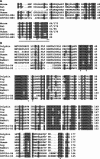Genome of deerpox virus
- PMID: 15613325
- PMCID: PMC538591
- DOI: 10.1128/JVI.79.2.966-977.2005
Genome of deerpox virus
Abstract
Deerpox virus (DPV), an uncharacterized and unclassified member of the Poxviridae, has been isolated from North American free-ranging mule deer (Odocoileus hemionus) exhibiting mucocutaneous disease. Here we report the genomic sequence and comparative analysis of two pathogenic DPV isolates, W-848-83 (W83) and W-1170-84 (W84). The W83 and W84 genomes are 166 and 170 kbp, containing 169 and 170 putative genes, respectively. Nucleotide identity between DPVs is 95% over the central 157 kbp. W83 and W84 share similar gene orders and code for similar replicative, structural, virulence, and host range functions. DPV open reading frames (ORFs) with putative virulence and host range functions include those similar to cytokine receptors (R), including gamma interferon receptor (IFN-gammaR), interleukin 1 receptor (IL-1R), and type 8 CC-chemokine receptors; cytokine binding proteins (BP), including IL-18BP, IFN-alpha/betaBP, and tumor necrosis factor binding protein (TNFBP); serpins; and homologues of vaccinia virus (VACV) E3L, K3L, and A52R proteins. DPVs also encode distinct forms of major histocompatibility complex class I, C-type lectin-like protein, and transforming growth factor beta1 (TGF-beta1), a protein not previously described in a mammalian chordopoxvirus. Notably, DPV encodes homologues of cellular endothelin 2 and IL-1R antagonist, novel poxviral genes also likely involved in the manipulation of host responses. W83 and W84 differ from each other by the presence or absence of five ORFs. Specifically, homologues of a CD30 TNFR family protein, swinepox virus SPV019, and VACV E11L core protein are absent in W83, and homologues of TGF-beta1 and lumpy skin disease virus LSDV023 are absent in W84. Phylogenetic analysis indicates that DPVs are genetically distinct from viruses of other characterized poxviral genera and that they likely comprise a new genus within the subfamily Chordopoxvirinae.
Figures


References
-
- Afonso, C. L., E. R. Tulman, Z. Lu, L. Zsak, N. T. Sandybaev, U. Z. Kerembekova, V. L. Zaitsev, G. F. Kutish, and D. L. Rock. 2002. The genome of camelpox virus. Virology 295:1-9. - PubMed
-
- Alonso, D. M. W., and M. W. Radomski. 2003. The nitric oxide-endothelin-1 connection. Heart Fail. Rev. 8:107-115. - PubMed
MeSH terms
Substances
Associated data
- Actions
- Actions
LinkOut - more resources
Full Text Sources
Other Literature Sources
Research Materials
Miscellaneous

